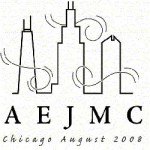Health Journalists Face Translation Challenge, Missouri Journalism Researchers Find
Majority of Health Journalists Lack Specialized Training, Nearly Half Not Familiar with Health Literacy
By Emily Smith
MU News Bureau
Columbia, Mo. (Aug. 22, 2008) — The media constantly inform the public of new health information, but many Americans have difficulty recognizing what they should, or should not do to improve their health. Missouri School of Journalism researchers conducted a national survey and found that the majority of health journalists have not had specialized training in health reporting and face challenges in communicating new medical science developments.
Assistant Professors Amanda Hinnant and María Len-Ríos surveyed 396 newspaper and magazine journalists and completed 35 in-depth interviews to offer insight into the role of journalists in reducing the negative effects of limited health literacy. Health literacy, as defined by the American Medical Association, is “the ability to obtain, process and understand basic health information and services needed to make appropriate health decisions and follow instructions for treatment.”
“Health journalists…have to resist ‘bogging down’ the story with too much technical science data and ‘dumbing down’ the story with overly simplistic recommendations.”
María Len-Ríos
“Almost half of the journalists reported they were not familiar with the concept of health literacy, but said that their readers’ ability to understand health information was very important to consider when writing health stories,” Hinnant said. “Increasing knowledge of health literacy could help journalists clarify medical information to readers.”


Of the journalists surveyed, only 18 percent had specialized training in health reporting and only 6.4 percent reported that a majority of their readers change health behaviors based on the information they provide. The journalists had an average of 18 years of journalism experience and seven years experience as health journalists.
“Health journalists play an important role in helping people effectively manage their health,” Len-Ríos said. “However, we found that many journalists find it difficult to explain health information to their readers, while maintaining the information’s scientific credibility. They have to resist ‘bogging down’ the story with too much technical science data and ‘dumbing down’ the story with overly simplistic recommendations.”
Journalists reported quoting medical experts, avoiding technical terms, and providing data and statistics as the three most important elements to making health information understandable. However, understanding numbers is a challenge for many people, Hinnant said. According to the U.S. Department of Education 2007 report, mathematics literacy is a serious problem in the United States. Only 39 percent of U.S. students are at or above the “proficient” level in grade eight and only 23 percent are at that level by grade 12. Mathematical knowledge is important to understand health information, Hinnant said.
“A large percentage of Americans are not health literate, which is related to significant health problems including medication errors, failing to seek treatment and an inability to understand directions about proper health behavior,” Hinnant said. “The role of a health journalist includes translating medical information and acting as a liaison responsible for providing quality information. We need to actively find ways to improve health coverage and recognize the importance of the media’s role in improving the public’s quality of life.”
According to the survey, journalists have complex views of what their readers can understand. A majority of journalists reported believing that their readers understand information from medical professionals, but are not proficient with scientific information and more prone to believe health myths. More than half of the respondents thought a majority of their readers used information simply to gain a better understanding of health issues or used it to communicate better with health professionals. The results suggest that newspaper journalists view their roles as information providers, while magazine journalists perceive themselves more as advocates for behavioral change.

Results from the study, “Tacit Understandings of Health Literacy: Interview and Survey Research with Health Journalists,” were presented at the 2008 Association for Education in Journalism and Mass Communication Convention in Chicago. The paper received the Top Faculty Paper Award from the Science Communication Interest Group. The research was funded by the Missouri Foundation for Health and the Missouri Health Literacy Enhancement Priority Area Grant.
The Missouri School of Journalism is home to several health communication research initiatives, including the Association of Health Care Journalists, an independent membership organization dedicated to advancing public understanding of health care issues. Its mission is to improve the quality, accuracy and visibility of health care reporting, writing and editing. The Health Communication Research Center is a grant-funded center based at the School. Its primary mission is to foster interdisciplinary research to improve communication between the health care community and the public. The center capitalizes on the University of Missouri‘s strengths in health care outreach, education and prevention.
Updated: April 28, 2020